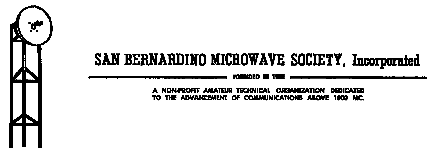

President Doug Millar, K6JEY 2791 Cedar Ave Long Beach, CA 90806 562-424-3737 dougnhelen@moonlink.net
VP Dave Glawson, WA6CGR 23437 E Amberwick Pl Diamond Bar CA 91765 909-861-7036 wa6cgr@ham-radio.com
Recording Sec Mel Swanberg, WA6JBD 231 E Alessandro Blvd Riverside, CA 92508 909-369-6515 swanberg@pe.net
Corresponding Sec Kurt Geitner, K6RRA 1077 E Pacific Coast Highway #142 Seal Beach, CA 90740 310-710-7810 k6rra@gte.net
Treasurer Dick Kolbly, K6HIJ 26335 Community Barstow, CA 92311 760-253-2477 rkolbly@compuserve.com
Editor Bill Burns, WA6QYR 247 Rebel Rd Ridgecrest, CA 93555 760-375-8566 bburns@ridgecrest.ca.us
Webmaster Chip Angle, N6CA 25309 Andreo Lomita, CA 90717 310-539-5395 chip@anglelinear.com
ARRL Interface Frank Kelly, WB6CWN 1111 Rancho Conejo Blvd. #501 Newbury Park, CA 91320 805-499-8047 fk@event1.com
W6IFE License Trustee Ed Munn, W6OYJ 6255 Radcliffe Dr. San Diego, CA 92122 619-453-4563 edmunn@compuserve.com
At the 2 May 2002 meeting of the SBMS the topic will be Noise Figure for beginners. Jeff, KN6VR will have a short presentation on noise figure followed by a workshop on measurement. We will have two stations: one to calibrate noise sources up to 24 GHz at ham band frequencies. We will have another station to measure noise figure and gain for preamps and transverters from 2 meters on up, including 24 GHz. It should be a good chance to get some good numbers for the group. There will be an update on the 24 GHz project and plenty of roundtable sharing of projects. The SBMS meets at the American Legion Hall 1024 Main Street (south of the 91 freeway) in Corona, CA at 1900 hours local time on the first Thursday of each month. Check out the SBMS web site at http://www.ham-radio.com/sbms/.
(More info from Doug on the measurement session- we will have three test setups using noise gain analyzers. WA6CGR and K6HLH will have Eaton analyzers and K6JEY will bring an HP8970A. We will be able to measure noise figure from 10 MHz to 26.5 GHz with calibrated sources. So if you have a converter or preamp that needs measuring, bring it. We will also have power measurement capability for the same frequency range up to 1 watt. We are going to be mainly set up to measure power at 24 GHz. So, if you at a point where you want to measure the level of your LO or output, we will be able to do that. Obviously, we can measure at the lower bands at the same power level.)
Prez Says- I would like to thank last year's officers, who are also mostly this year's officers as it turns out for their good work this past year. I would especially like to thank Dick (WB6DNX) for his support and ideas as Vice President this past two years. He was always there for support, to give ideas and was happy to take over meetings whenever it was necessary. Thanks!
Thanks also to Bill (WA6QYR) for doing such a great job on the newsletter all year and Kurt (K6RRA) for supplying many of the pictures. Thanks to Dick (K6HIJ) for his continuing fine efforts in keeping the books straight, and to Mel (WA6JBD) for his work as secretary.
When the steam and soot had cleared from the SBMS railroad, we had a new Vice President: Dave Glawson WA6CGR, who has always been a leader in the club, but now has a title!
When the steam had cleared, I also found that I was reelected for a third term as president. But I also found that I had made a campaign promise to not tell any more jokes during the meetings- evidently a key factor in my reelection! So as part of the new Doug and Dave administration, I will no longer attempt to tell jokes at the beginning of the business meeting. (It is just as well. I was running out of "good" ones.) However, I hope I can be excused for the occasional pun or innuendo that may arise in the exercise of my duties. I consider it a privilege and a great deal of fun to be president of SBMS appreciate being reelected.
We should have an exciting year with projects in process on 24 and 47 GHz., the contest in Aug. and Sep. and meetings with the usual camaraderie and technical interest. I did notice that at the April meeting we set a new record for the technical roundtable. It took an hour for everyone to talk about what they had been doing the previous month. I remember times when it took less than 10 minutes. It is one of the best times of the meeting and seeing what people are doing and how they are solving problems is part of the center of the benefit of the club. Doug, K6JEY
Maury Microwave Tour
On April 4th a group of members assembled at the Maury Microwave plant in Ontario for a tour. Jim Adamason, AE6JA, gave us the tour. The company continues the AIL/Eaton noise figure equipment line, and makes RF connectors and connector calibration sets. We met in the conference room and got to see displays of the things they make. We got an overview of what they do and a tour of the facility. Their machine shop was very impressive. We got to see the type of hyper accurate machining they are able to do. The tech that repairs the noise figure meters was able to supply us with some good information on the repair of our noise figure meters. In addition, they had an Eaton noise figure and gain meter set up for us so that we could do relative measurements on noise generators to get an idea of what their ENR levels were. We also had an extensive chat with the president, David Maury, in his office.
It was an excellent trip and we are grateful to Messrs Maury and Adamson for their hospitality and the tour. Doug, K6JEY
Last meeting- Chuck, WA6EXV had a presentation on basics of dish and cassegrain antennas. Chuck has a simple DOS program to help calculate dish data. Contact him at chuckswed@juno.com to get a copy. Chip, N6CA demonstrated his flat plate reflector cassegrain dish and gave some hints on construction. John, KJ6HZ talked about antennas for AO-40 and demonstrated the different feeds that one can simply build. John's handout is included in this month's newsletter and comes from data on Paul Wade's antenna book on line. Art, W6XD talked about an ARRL program on Amateur Radio Interference band watchers and the upcoming South West Convention. Welcome to new member Pete, W6DXJ of San Diego. Visitors included Howard, KG6BIB of Ramona, Steve, AD6HT of Hacienda Heights, Art Goddard, W6XD of ARRL, Robert, KR7O of Madera, Joe, KB6UCO of Palos Verdes, Mike, KB6MQQ of Cucamonga and Rick, W6ESS of Placentia. Welcome to all. The field trip to Maury Microwave was attended by xx members. The tour included a machine shop visit, which impressed some of the commercially employed SBMS folks. Demonstrations of equipment were informative. Thanks to Doug, K6JEY for arranging the tour. 31 people present.
Scheduling
June 6 Interfacing techniques for transverters and IF radios.
June 8-10, 1800Z - 0300Z - ARRL June VHF QSO Party
July 4. NOTE THIS IS A HOLIDAY Lets vote on it next meeting and decide.
August 1 Contest get ready session. Maps, advice, supply lists and liaison information
August 3-4, 1800Z - 1800Z - ARRL UHF Contest
August 12, 1720Z - Perseids meteor shower
August 17-18, 8 AM - 8 PM - ARRL 10-GHz Cumulative Contest
September 5 K6JEY session on frequency measurement and calibration.
September 14-16, 1800Z - 0300Z - ARRL September VHF QSO Party
September 21-22, 8 AM-8 PM - ARRL 10-GHz Cumulative Contest
Sept-Oct, dates TBA, Fall Sprints
October 3 24 GHz testing and equipment review. Bring your rig and get it tested.
October 24-27 - Microwave Update 2002/Eastern VHF-UHF combined Conference
sponsored by N.E.W.S.
November 7 WA6JBD program on Network Analyzers.
November 19, 0040Z - Leonids meteor shower
December 5 5.7 GHz gear report and testing.
December something Christmas party at Dave's??
December 14, 1000Z - Geminids meteor shower
July 4th Meeting? We are supposing that the Legion will want to use the hall on July 4th. We will decide during the meeting in May what we will do: cancel the meeting in July, change the date or change the location. We will let you know on line, on the website and in the newsletter.
Wants and Gots for Sale
For Sale HP-10544 10 MHz osc John, N6AX 714-993-0435
Want WR-90 to SMA transitions Richard WW7D 949-855-4689
Want HP435 power meter sensor pin connections Dick K6HIJ 760-253-5127
For Sale Kenwood TS700A all mode 2 mtr $185 Dick, WB6DNX 714-529-2800
Want about 8 inches of WR-42 waveguide John, KJ6HZ 909-683-1434
47 GHz Transverters Available What? Yes. We have a small quantity of transverters available for the 47 GHz band for narrowband use. Here is what they are: they are the modules W0EOM described in the 2001 update. It is the "Large" converter on P. 110- 111. They have a finline waveguide input to a passive mixer and need to have the IF trace routed to an SMA connector whose place is pre drilled on the block. The original IF amplifier is not used. The LO is a passive tripler from 12 GHz. With a 10.368 GHz IF and an LO of 12.240 GHz, the input and output are 47.088 GHz. An easy and cheap antenna to use is an Edmund Scientific optical dish. (Mel has been experimenting with one.) According to W0EOM they were able to get about 3 miles with this type of setup. Mel, Dennis and I will be presenting working models for the program at the Dec. meeting. Ten or so are available now at $25 from K6JEY and will be available at the meeting. I will also have information for them. Note: there are VERY small "wire" bridges over the diodes that are easily bent when the unit is taken apart. If they short to the diode, the diode goes out when you power it up. You need a microscope to even find the diode, much less replace it. Doug, K6JEY
Activity reported at the 4 April SBMS meeting- Doug, K6JEY has a newer calibrated noise source and has been working on his 24 GHz rig; Mel, WA6JBD has been reworking his 10 GHz rig; Chip, N6CA has a new 3 GHz antenna, built filters for the 1.2-2.4 translator, and says the Palos Verdes beacon is still working just fine; John, N6AX has been working on his 24 GHz rig per N6IZW approach; Rick, W6ESS is working n his 10 GHz rig and has a K2 IF radio; John, KJ6HZ has been working on his Prime star feeds; Kurt, K6RRA helped others get on the air and has 2 two meter Gonset radios; Dennis, WA6NIA is making slow progress on his 10 GHz rig and has acquired new test gear; Art, W6XD talked about an ARRL program on Amateur Radio Interference band watchers and the upcoming South West Convention; Joe KB6UCO has been collecting gear; Mike, KB6MQQ has been keeping the CMRA radios running; Chris, N9RIN has been working on the relay out of the Pcom converter boards; Joonho, HM1AI is wanting to build his 10 GHz rig; Richard, WW7D has a FT-817 and some rig pieces; Dick, K6HIJ was off traveling to develop some oven magnetron equipment; Jeff, KN6VR moved; Steve, AD6HT is working on a 3 GHz rig; Glenn, KE6HPZ is working on a laser communicator; Larry, K6HLH is repackaging his 1296 transverter for pole mount; Dave, WA6CGR successfully tested the 3075 Pcom converter board and will be testing the IZW mixers on the same board; Ken, WB6DTA is building a DEM 3 GHz transverter for W6SAY and the 1296 antenna broke at home; Dick, WB6DNX is redoing a kitchen; Gary, W6KVC is moving; Gordon, WA6FMX attended an IEEE antenna talk of some questionable technical correctness; Chuck, WA6EXV has been working on the 1.2 to 2.4 GHz translator antennas; Bill, WA6QYR got his 3.4 Transverter with 20 w power amp working, and is building a Directive Systems 3.4 GHz loop yagi; Robert, KR7O has gear for 160 Meters through 10 GHz.
Information off the WEB. -- The original site of the W1GHZ 10 GHz web page is going away
at the end of April. www.tiac.net will be no more, so the URL will no longer work.
Please update your bookmarks and links on other pages to: www.w1ghz.org and my email to: w1ghz@arrl.net. These addresses should last longer than most of the ISPs out there. The www.w1ghz.cx URL should continue for a while - it's paid up through 2004, but the Christmas Island registry seems to be defunct. www.qsl.net/n1bwt is also alive and well, and I'll be working on making that a true mirror site as a backup, since the current host for my main site may not be permanent. If you find any broken links or any that still point to tiac.net, please let me know. 73 Paul
After trying for weeks to hear the Santiago Beacon, or anything at all for that matter, I dragged the 10 GHz rig to work, which is located on some high ground. Picked out the P.V. beacon 20+ over s9, even heard Frazier... so the rig works. Great. Then I decided to try Santiago again. Now, here in Riverside, I can normally hear it inside on a horn, but it's been dead. Today I heard it. P.V. was far stronger. Took a 2' dish, and 2 db NF 18 miles away to hear it, but it's there. Mel WA6JBD
Just a short note to report that I worked WA6CGR in Diamond Bar and WA6MEM on PV this weekend on 10 GHz from near my home QTH in Thousand Oaks, CA. Direct path signals were good for SSB and CW contacts with both stations. Looking forward to the summer radio season! Frank WB6CWN
I'd like to report completion of a QSO using AO-40's K band transponder. The SSB contact was made Saturday 04/20/2002 at 1737 UTC between Jerry, K5OE and myself, Mike N1JEZ. I was using L band up (1269 MHz) and K band (24,048 MHz) down. Jerry was using L Band up (1269 MHz) and S Band down (2401 MHz). AO-40 was 63,000 km away at the time. Elevation for me was 10 degrees above the horizon. AO-40 was showing a squint of ~ 5 degrees at the time. The AMSAT Web site lists AO-40's K Band transponder as having a power of 1 watt into a 23 dB horn. I used a 0.5 meter dish with a linear feed. Because of this, there was pretty severe fading due to the fact AO-40 is currently spinning. Pictures and audio of the contact are available at http://members.aol.com/mike73. I had two more successful contacts the following day and hope to post that audio as well soon. 73, Mike, N1JEZ FN34im
NEWINGTON, CT, Apr 4, 2001--The FCC has again targeted Amateur Radio's primary allocation at 2390 to 2400 MHz for possible sharing or use by other radio services. A Notice of Proposed Rulemaking (WT Docket 02-55)--released in mid-March but not yet available for public comment--invites comments on either sharing the band with public safety services being displaced from 800 MHz or moving amateurs elsewhere. The ARRL plans to file comments in the proceeding.
The FCC says increasing incidents of harmful interference to public safety systems in the 800-MHz band prompted the rulemaking proceeding, "Improving Public Safety Communications in the 800 MHz Band." To alleviate the problem, the Commission now is exploring the possibility of restructuring the 800 MHz band and moving some occupants elsewhere.
"In this proceeding, if commenting parties believe that incumbent amateur services cannot co-exist with relocated 800 MHz services," the FCC said, "we seek comment on whether incumbent amateur services could be relocated, what spectrum could be used for their relocation, and what procedures would apply to such relocation." The FCC NPRM identifies the 2390-2400 MHz band as an "Unlicensed PCS Band." Unlicensed, asynchronous PCS devices were authorized there in 1995, but Amateur Radio remains primary on the segment.
The FCC also will seek comments on whether existing UPCS operations could continue in the band or be forced to cease. It also wants input on "the suitability of the 2390-2400 MHz band as replacement spectrum and whether there are other band segments with which this band could be paired." The FCC noted that the adjacent 2385-2390 MHz segment already is slated for auction.
The FCC said its discussion of 2390-2400 MHz and other segments in terms of replacement spectrum was intended to be "illustrative rather than exclusive" and that other bands "may also merit consideration."
Just last summer, the FCC invited comments on its proposals to reallocate some spectrum in the 2390 to 2400 MHz amateur segment--as well as in the non-amateur 1.9 and 2.1 GHz bands--for possible use by unspecified mobile and fixed services. The Commission has proposed 2390 to 2400 MHz and other bands to support the introduction of advanced wireless systems, including so-called third-generation (3G) mobile systems. The FCC also has asked for comments on whether amateurs could share the band with
government users. Should it reallocate 1755-1850 MHz--now occupied by federal government users--for advanced wireless services, the Commission has hinted that it might consider again lumping relocated federal government users with amateurs on 2390-2400 MHz.
The ARRL has petitioned the FCC to upgrade the adjacent Amateur Radio 2400-2402 MHz allocation from secondary to primary, mainly to protect satellite operations. The AO-40 satellite has been successfully using the band for downlink telemetry and transponder operation, and AMSAT plans a similar downlink for its next satellite project. The Amateur Service already is primary at 2402-2417 MHz. There's a secondary amateur allocation at 2417-2450 MHz.
The 2390-2400 MHz band was reallocated from federal government to exclusive non-government use pursuant to the Omnibus Budget Reconciliation Act of 1993. When the FCC elevated Amateur Radio from secondary to primary status on the band in 1995, it also allocated the spectrum for use by unlicensed Part 15 devices, reasoning that hams and unlicensed devices had proven able to share spectrum, and it wanted to preserve adequate spectrum for Amateur Radio. At about the same time, the FCC concluded that
An allocation for certain proposed wide-area, high-power fixed and mobile services "would be incompatible with amateur use."
Last year, the ARRL re-petitioned the FCC for primary status at 2300 to 2305 MHz. That petition faces competition from AeroAstro, which wants co-primary status with the Amateur Service for its commercial satellite-based location service.
The complete NPRM is available via the FCC Web site. The FCC will officially invite comments for 30 days after the NPRM is published in the Federal Register. Reply comments will be due 60 days following publication in the Federal Register. Some related notices and correspondence already are available via the FCC's Electronic Comment Filing System. Click on "Search for Filed Comments" and enter "02-55" in the "Proceeding" field.
Hi all, Here are some pix of the DN71/DN72 outings of last week. The truck is set up for 2304. The first outing was to DN71nb at Cheyenne. I wanted to be sure the 3-band rig was together and working properly. The rig uses a common reference osc and plug-ins for each band. The plug-ins contain a mixer, filter and rx preamp. The antenna is a 4' dish with a 3-band pc card feed. (I also carry 'real feeds' for each separate band). The rig uses a 2.5-watt p.a., which is an Avantek 2-6 GHz unit. It also uses a broadband rx preamp. Noise figure is about 4-5 dB. Not spectacular, but good enough for all but the most difficult conditions. At DN71nb I worked K0RZ, N0UGY and W6OAL on 3456. I worked K0RZ and W6OAL on 2304 and worked K0RZ on 5760. Signals were good on all bands.
The next outing was to DN72. The landscape is looking south from Swan road east of Wheatland, WY in DN72pa. It is a good horizon for microwave launching. The 433.1 liaison channel was s2-s6 when we started at 0900. As time went on, it got worse. By about 1130 when we ended it was starting to be a problem. I should have taken the long yagi instead of the little 3 element 440 ant.
We started with x-band. My rig runs 1 watt into a water pipe feed in a 4' dish. K0RZ's signals were about s2 and sounded 'watery', like a scatter signal. There was also flutter on the 433.1 signals. We completed the contact in CW. I next moved the dish slightly west, and contacted WD4MUO in Flagstaff Park. His signals were about s1. We completed that contact in CW also.
The next band was 3456. The signals from K0RZ were about s2 and again we used CW. No signals were heard by N0UGY or W6OAL.
Next we went to 2304. Bill's signals were s2-s4. We might have made that one on voice, but we used CW for an easy contact. I tried with W6OAL, but I could not hear him at all. We were unable to complete the contact.
The last band was 5760. Bill was very weak. A steady carrier sounded like bad CW. I changed from my 3 band pc board feed to a 'real feed' of WR137 waveguide. That was enough better to complete the contact in CW.
The outings were fun and I am looking forward to more this summer. 73 Phil, W6HCC
Phil, W6HCC/0 multi-band set up on the back of his truck as described in the text above. Photo via W6HCC. (below)
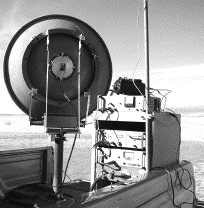
Chip, N6CA talked about the design of his flat plate cassegrain feed for 10 GHz at the May SBMS meeting. Simple to build with the directions provided. The blockage of the flat plate is minimal part of the gain of the overall antenna. Photo by Kurt, K6RRA. (below)
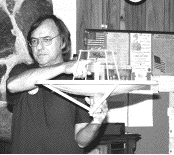
John, KJ6HZ talking about a 24 GHz dish and feed at the May meeting of SBMS. John had a number of antennas to show and talk about. Everyone got to see a number of different types to look at mounting and difficulty of adjustment. Photo by Kurt K6RRA. (below)
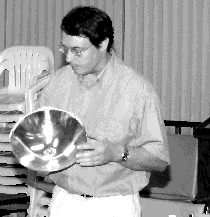
Art Goddard, W6XD ARRL Southwestern Division Director stopped in the May SBMS meeting to talk about monitoring interfering signals on the amateur bands from commercial sources. Photo by Kurt, K6RRA. (below)
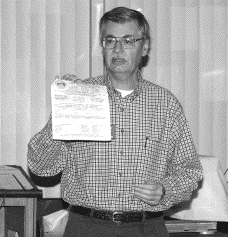
The San Bernardino Microwave Society is a technical amateur radio club affiliated with the ARRL having a membership of over 90 amateurs from Hawaii and Alaska to the east coast. Dues are $15 per year, which includes a badge and monthly newsletter. Your mail label indicates your call followed by when your dues are due. Dues can be sent to the treasurer as listed under the banner on the front page. If you have material you would like in the newsletter please send it to Bill WA6QYR at 247 Rebel Road Ridgecrest, CA 93555, bburns@ridgecrest.ca.us, or phone 760-375-8566. The newsletter is generated about the 15th of the month and put into the mail at least the week prior to the meeting. This is your newsletter. SBMS Newsletter material can be copied as long as SBMS is identified as source. San Bernardino Microwave Society newsletter
247 Rebel Road
Ridgecrest, CA
93555
USA